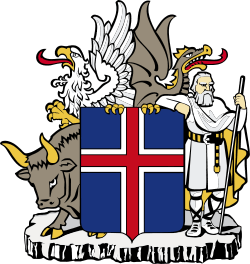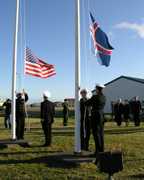Iceland in the Cold War
Part of a series on the |
||||||||||||||||||||||||
|---|---|---|---|---|---|---|---|---|---|---|---|---|---|---|---|---|---|---|---|---|---|---|---|---|
| History of Iceland | ||||||||||||||||||||||||
 | ||||||||||||||||||||||||
| Middle Ages | ||||||||||||||||||||||||
|
||||||||||||||||||||||||
| Modern era | ||||||||||||||||||||||||
|
||||||||||||||||||||||||
| Related topics | ||||||||||||||||||||||||
| Timeline | ||||||||||||||||||||||||
| Iceland portal | ||||||||||||||||||||||||
Throughout the Cold War, the nation of Iceland was a member of the North Atlantic Treaty Organisation (NATO) and allied with the United States, hosting a US military presence in Keflavík Air Base from 1951 to 2006.
In 1986, Iceland hosted a summit in Reykjavík between United States President Ronald Reagan and Soviet Premier Mikhail Gorbachev, during which they took significant steps toward nuclear disarmament.
Five years later, in 1991, Iceland became the first country to recognize the renewed independence of Estonia, Latvia, and Lithuania when they broke away from the Soviet Union.
Background
Early in World War II, the neutral Kingdom of Iceland had declined an offer of British protection. A month after the occupation of Denmark by Nazi Germany in 1940, the British invaded Iceland, violating the country's neutrality, over the formal protest of Iceland's regent, Sveinn Björnsson. In 1941, the British arranged for the United States to take over occupation of the country so that British troops could be used in other arenas of the war. After pressure from the British, the Icelandic government eventually agreed to US occupation, and on June 7, 1941 five thousand US troops arrived in Iceland. The United States supported the founding of the Republic of Iceland in 1944, and promised to withdraw its troops once the war ended, but when Nazi Germany was defeated in 1945, the US decided that it wanted to keep troops in Iceland, which was strategically located for monitoring aerial and naval activity in the North Atlantic. The Icelandic government would not agree to a permanent American military presence, but the US refused to leave.[1]
The Cold War
The Keflavík Agreement
In late 1946, Icelandic Prime Minister Ólafur Thors of the right-wing Independence Party made a deal with the United States, the so-called Keflavík Agreement. This ended the previous co-operation between the Independence Party and the left-wing Socialist Party. The Keflavík Agreement stipulated that the United States military would leave the country within six months and that the US-built Keflavík Airport would become the property of the Icelandic government. The US would be allowed to keep civilian staff in the country to oversee military shipping to mainland Europe. The agreement was passed into law by the Althing with 32 votes against 19. This ended the war-time coalition government, which had enacted Iceland's republican declaration of independence in 1944; many in the centrist and left-wing parties felt that the Keflavík Agreement was a violation of Iceland's policy of neutrality. In the wake of this rift, the Cold War shaped Icelandic politics for the next decades.[2][3][4]
Iceland joins NATO
The right-wing Independence Party, the centrist Progressive Party and the Social Democrats were in favour of joining NATO, but the Socialist Party was opposed. In 1949, as the Althing debated NATO membership, people flocked to Lækjartorg and Austurvöllur in downtown Reykjavík, the capital of Iceland. Fighting broke out and soon escalated into a riot; right-wing recruits and police assaulted protestors and dispersed them with tear gas.
The Progressive Party, the Social Democrats, and the Independence Party, under the leadership of Social Democrat Prime Minister Stefán Jóhann Stefánsson decided that Iceland should join NATO in March 1949, with the condition that the US military would not maintain troops in the country during peacetime. This condition, however, was informal, and nowhere explicitly stated in the agreement. The Socialist Party was the only Icelandic political party opposed to NATO membership.
Iceland had prospered during the war, and the immediate post-war period was followed by substantial economic growth, driven by industrialisation of the fishing industry and the Marshall Plan programme, through which Icelanders received by far the most aid per capita from the United States of any European country (at USD 209, with the war-ravaged Netherlands a distant second at USD 109).[5][6] This may have influenced the Icelanders' willingness to co-operate with the United States.[7][3]
In 1951, a new agreement was made with the United States through NATO. According to this defense treaty, the United States accepted full responsibility for the defence of Iceland for an unspecified period of time. This new agreement annulled the Keflavík Agreement.
Iceland as an ally of the United States

From 1951, the United States maintained several thousand troops and several jet interceptors in the Keflavík Air Base; this was the Iceland Defense Force. The US military did not leave the country until 2006.
Although Iceland remained allied with the US throughout the Cold War, the country continued to trade with the Soviet Union, and domestic opposition to the US military presence was strong, led by the Icelandic Anti-War Movement (Icelandic: Samtök hernámsandstæðinga, later Samtök herstöðvarandstæðinga).
Leverage in the Cod Wars
During the so-called Cod Wars, disputes with the United Kingdom over fishing-rights in the North Atlantic Ocean, the Icelandic government pressured the United States for support against the British, threatening to close the Keflavík Air Base unless its demands were met.
1986 Reagan-Gorbachev Summit in Reykjavík

Iceland hosted a summit in Reykjavík in 1986 between United States President Ronald Reagan and Soviet Premier Mikhail Gorbachev, during which they took significant steps toward nuclear disarmament. Only a few years later, in 1991, when Jón Baldvin Hannibalsson was foreign minister, Iceland would become the first country to recognize the independence of Estonia, Latvia, and Lithuania as they broke away from the Soviet Union.
The End of the Cold War

By the end of the Cold War, the town of Keflavík on the Reykjanes peninsula had become economically dependent on the US Air Base. Icelandic politicians lobbied US policy-makers, encouraging them to maintain the Icelandic Defense Force, even as Iceland's location ceased to be strategically important following the cessation of hostile rivalry between the United States and the Soviet Union.
In 2006, the US made the unilateral decision to close the base and withdraw its troops, over the protests of Independence Party and Progressive Party politicians, many of whom felt betrayed by the US military abandonment of Iceland. Under the government of Halldór Ásgrímsson, a diplomatic mission was sent to Washington, D.C. to persuade the US military to stay, but it met with no success.
Iceland remains a member of NATO and is still under the military protection of the United States, even if the economic benefits of the US military presence are gone. With the withdrawal of US forces, the country's military co-operation with other allied NATO countries, such as Norway, has increased.
References
- ↑ Gunnar Karlsson (2000): 58-63.
- ↑ Gunnar Karlsson og Sigurður Ragnarsson (2006): 271.
- ↑ 3.0 3.1 Gunnar Karlsson (2000): 62.
- ↑ Árni Daníel Júlíusson og Jón Ólafur Ísberg (2005): 376.
- ↑ Vísindavefurinn: ''Hversu há var Marshallaðstoðin sem Ísland fékk eftir seinni heimsstyrjöld?''. Visindavefur.hi.is (2003-05-13). Retrieved on 2012-04-28.
- ↑ Margrit Müller, Pathbreakers: Small European Countries Responding to Globalisation and Deglobalisation, p. 385.
- ↑ Árni Daníel Júlíusson og Jón Ólafur Ísberg (2005): 380.
Sources
- Árni Daníel Júlíusson & Jón Ólafur Ísberg. Íslands sagan í máli og myndum. (Reykjavík: Mál og menning, 2005).
- Gunnar Karlsson. Íslandssaga í stuttu máli. (Reykjavík: Mál og menning, 2000).
- Gunnar Karlsson & Sigurður Ragnarsson. Nýir tímar. Saga Íslands og umheimsins frá lokum 18. aldar til árþúsundamóta. (Reykjavík: Mál og menning, 2006).
| |||||||||||||||||||||||||||||||||||||||||||||||

